headlights PORSCHE CAYNNE TURBO 2005 1.G User Guide
[x] Cancel search | Manufacturer: PORSCHE, Model Year: 2005, Model line: CAYENNE TURBO, Model: PORSCHE CAYENNE TURBO 2005 1.GPages: 369, PDF Size: 3.17 MB
Page 262 of 369

262
Maintenance, Car Care
Headlights, lights, interior and exterior
plastic partsfUseonlyclean water and a little dishwashing
detergent to clean headlights, lights, plastic
parts and surfaces.
Do not clean when dry.
Use a soft sponge or a soft, lint-free cloth.
Gently wipe the surface without applying too
much pressure.
The Porsche inside window cleaner is also
suitable for cleaning plastic surfaces.
Follow the cleaning instructions on the
container.
Never use other chemical cleaners or
solvents.
fRinse cleaned surfaces with clear water.
Door, roof, lid and window sealsfWash dirt (e.g. abrasion, dust, road salt or grit)
from all seals regularly using warm soapy wa-
ter. Do not use any chemical cleaning agents
or solvents.
When there is a frost hazard, the outer door seals
and the lid seals can be protected against freezing
into place by a suitable care product.
In order to prevent damage to the anti-fric-
tion coating, the inner door seals must not be
treated with care products.
Light alloy wheelsfPlease observe the chapter “AUTOMATIC CAR
WASHES” on Page 258.
Pitting may occur if metallic particles which cause
contact corrosion (e.g. brass or copper in brake
dust) are allowed to remain on the aluminum too
long.
fIf possible, wash the wheels with a sponge or
wash brush about every two weeks. In areas
where road salt or grit is spread on winter
roads or there is a lot of airborne industrial
dust, it is best to clean the wheels weekly.
The Porsche Light Alloy Wheel Cleaner
(ph-value 9.5) can be used for this pur-
pose.
If the ph-value of the detergent is in-
corect, the protective coating on the
wheels will be destroyed.
Polishes which dissolve oxides, such as those
frequently used for other metals, or abrasive
tools or agents are unsuitable because they
break down the oxide film of the protective
coating and will cause discoloration of the
wheel.
fEvery three months, after cleaning, coat the
wheels with a car wax or non-corrosive grease
(e.g. vaseline).
Using a clean cloth thoroughly rub the grease
into the surface.
Page 267 of 369

Practical Tips, Minor Repairs
267 Practical Tips, Minor Repairs
Exercise Extreme Caution when
Working on your Vehicle.............................. 268
Notes on Minor Repairs .............................. 269
Tires/Wheels ............................................. 269
Jack .......................................................... 283
Tool Kit ..................................................... 283
Lifting the Vehicle with a Lifting Platform
or Garage lift ............................................. 284
Compressor .............................................. 285
Wheel Bolts ............................................... 285
Changing Wheels........................................ 286
Flat Tire ..................................................... 287
Electrical System ....................................... 302
Battery ...................................................... 312
Emergency Starting with Jumper Cables ...... 323
Replacing the remote control battery ........... 326
Bulb Chart ................................................. 327
Replacing Bulbs ......................................... 328
Headlights ................................................. 329
Tail Light ................................................... 335
License Plate Lights ................................... 337
Headlight Adjustment.................................. 338
Changing Headlights from Left to
Right-Hand Traffic ....................................... 339
Towing ...................................................... 340
Page 313 of 369

Practical Tips, Minor Repairs
313
Winter operationDuring the winter months, battery capacity tends
to decrease as temperatures drop. Additionally,
more power is consumed while starting, and the
headlights, heater, rear window defogger, etc.,
are used more frequently.
Let your Porsche dealer test the battery's capaci-
ty before winter sets in.Vehicle storageIf the car stands for long periods in the garage or
workshop, the doors and lids should be closed.
fRemove the ignition key and, if necessary, dis-
connect the battery.
Notes on operation
fWhen the battery is disconnected, the alarm
system ceases to function.
If the vehicle was locked before the battery
was disconnected, the alarm will be triggered
when the battery is reconnected.
To deactivate the alarm system:
fLock the vehicle and unlock it again.Maintenance note
Even if you put your vehicle out of operation, the
battery still discharges.
The battery will discharge more quickly if your ve-
hicle is not driven on a daily basis over a distance
of several miles. The more often you drive your ve-
hicle, and the longer the distance driven on each
trip, the more opportunity the vehicle‘s charging
system will have to recharge the batteries.
fTo preserve its efficiency, charge the battery
about every 6 weeks.
fCheck the battery acid level and top off with
distilled water if necessary.
fStore a battery that has been removed in a
dark, cool place, but not subject to freezing.
Putting vehicle into operationAfter the battery is connected or charged, the
PSM warning light lights up on the instrument pan-
el and a message appears on the multi-purpose
display of the instrument panel to indicate a fault.
This fault can be remedied with a few simple
steps:
1. Start the engine.
To do this, turn the ignition key or the control
unit (on vehicles that have Porsche Entry &
Drive) to ignition lock position 2 twice.2. Perform a few steering movements and drive
a short distance in a straight line until the PSM
warning light goes out and the message is
erased from the memory of the multi-purpose
display of the instrument panel.
3. If the warnings does not go out, then:
Drive carefully to the nearest authorized
Porsche dealer.
Have the fault remedied by an authorized
Porsche dealer.
4. After the warnings disappear:
Stop the vehicle in a suitable place.
5. Perform adaptation of the power windows:
Please observe the chapter “STORING FINAL
POSITION OF THE DOOR WINDOWS” on
Page 31.
6. On vehicles with tire pressure monitoring sys-
tem:
Please observe the chapter “TIRE PRESSURE
MONITORING SYSTEM LEARNING PROCESS”
on Page 87.
Page 328 of 369
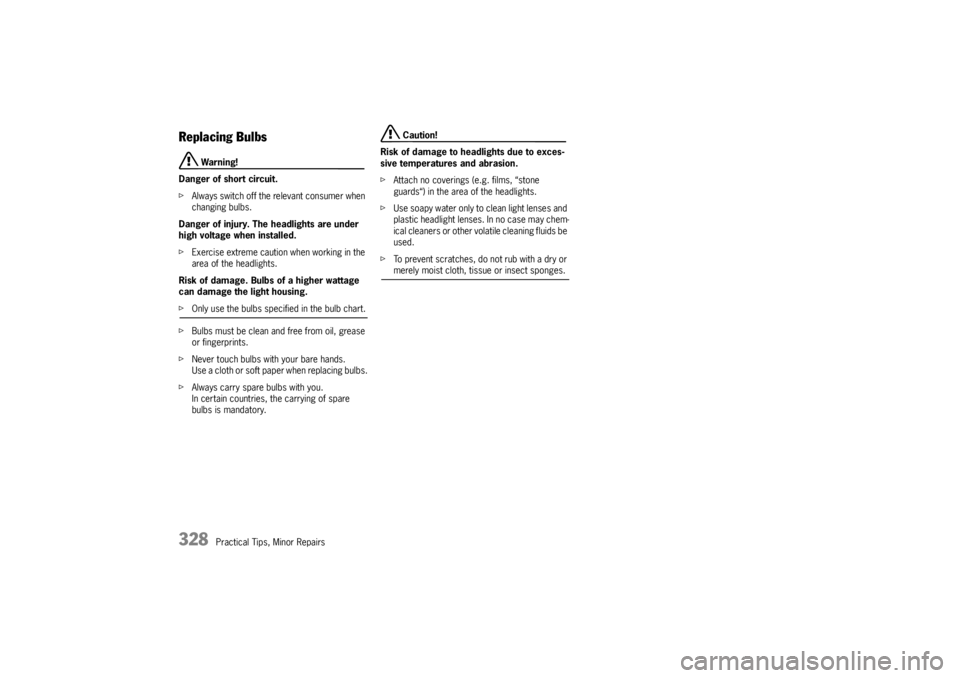
328
Practical Tips, Minor Repairs
Replacing Bulbs
Warning!
Danger of short circuit.
fAlways switch off the relevant consumer when
changing bulbs.
Danger of injury. The headlights are under
high voltage when installed.
fExercise extreme caution when working in the
area of the headlights.
Risk of damage. Bulbs of a higher wattage
can damage the light housing.
fOnly use the bulbs specified in the bulb chart.
fBulbs must be clean and free from oil, grease
or fingerprints.
fNever touch bulbs with your bare hands.
Use a cloth or soft paper when replacing bulbs.
fAlways carry spare bulbs with you.
In certain countries, the carrying of spare
bulbs is mandatory.
Caution!
Risk of damage to headlights due to exces-
sive temperatures and abrasion.
fAttach no coverings (e.g. films, “stone
guards“) in the area of the headlights.
fUse soapy water only to clean light lenses and
plastic headlight lenses. In no case may chem-
ical cleaners or other volatile cleaning fluids be
used.
fTo prevent scratches, do not rub with a dry or merely moist cloth, tissue or insect sponges.
Page 329 of 369
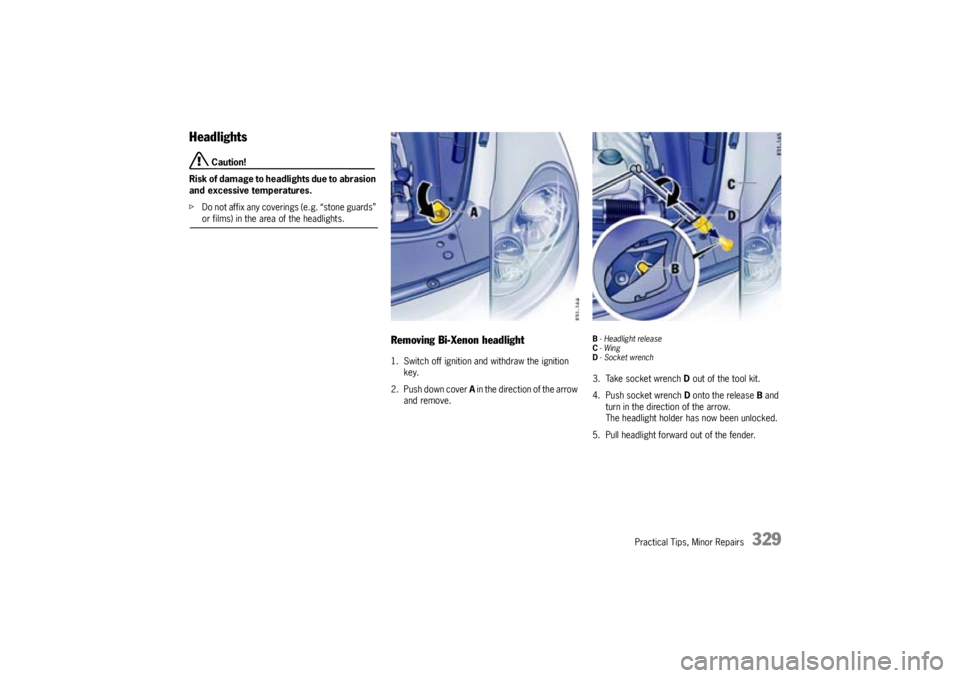
Practical Tips, Minor Repairs
329
Headlights
Caution!
Risk of damage to headlights due to abrasion
and excessive temperatures.
fDo not affix any coverings (e.g. “stone guards” or films) in the area of the headlights.
Removing Bi-Xenon headlight1. Switch off ignition and withdraw the ignition
key.
2. Push down cover A in the direction of the arrow
and remove.
B- Headlight release
C-Wing
D- Socket wrench3. Take socket wrench D out of the tool kit.
4. Push socket wrench D onto the release B and
turn in the direction of the arrow.
The headlight holder has now been unlocked.
5. Pull headlight forward out of the fender.
Page 330 of 369
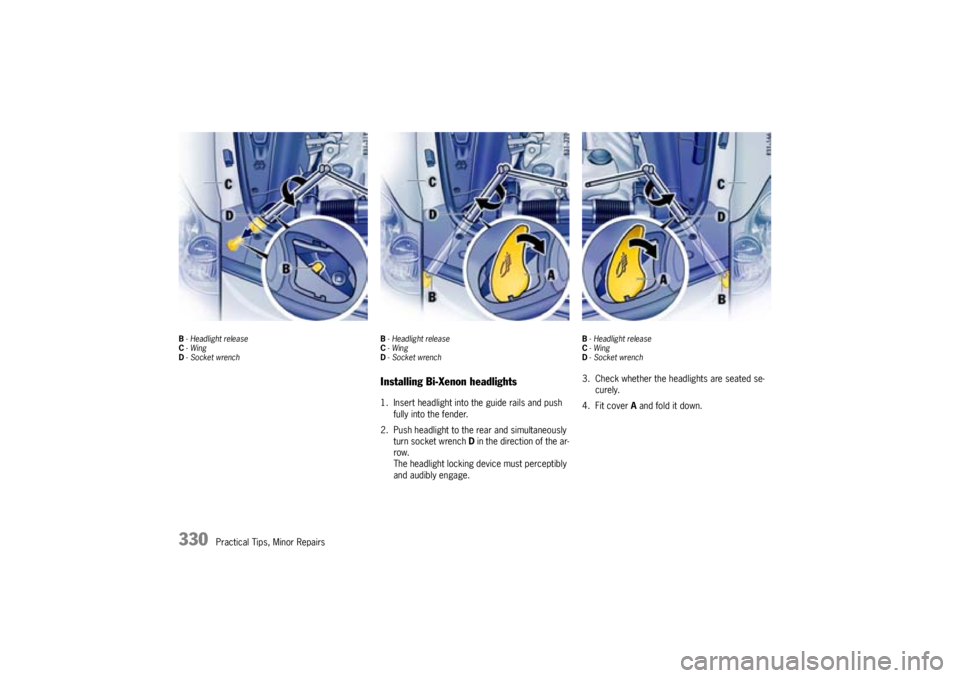
330
Practical Tips, Minor Repairs
B- Headlight release
C-Wing
D- Socket wrenchB- Headlight release
C-Wing
D-Socket wrench
Installing Bi-Xenon headlights1. Insert headlight into the guide rails and push
fully into the fender.
2. Push headlight to the rear and simultaneously
turn socket wrench D in the direction of the ar-
row.
The headlight locking device must perceptibly
and audibly engage.
B- Headlight release
C-Wing
D-Socket wrench3. Check whether the headlights are seated se-
curely.
4. Fit cover A and fold it down.
Page 331 of 369
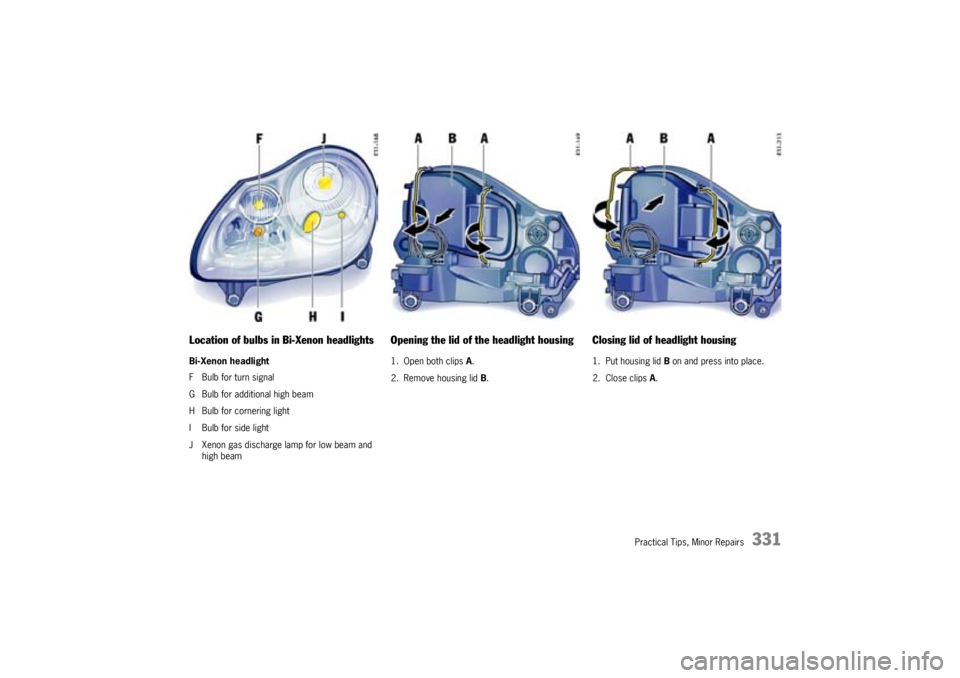
Practical Tips, Minor Repairs
331
Location of bulbs in Bi-Xenon headlightsBi-Xenon headlight
F Bulb for turn signal
G Bulb for additional high beam
H Bulb for cornering light
I Bulb for side light
J Xenon gas discharge lamp for low beam and
high beam
Opening the lid of the headlight housing1. Open both clips A.
2. Remove housing lid B.
Closing lid of headlight housing1. Put housing lid B on and press into place.
2. Close clips A.
Page 338 of 369

338
Practical Tips, Minor Repairs
Headlight AdjustmentfCheck tire pressure and adjust if necessary.
fPlease observe the chapter “TIRE PRESSU-
RES, COLD” on Page 350.
fPlease observe the chapter “REPLACING BUL-
BS” on Page 328.Adjustment
The adjustment is made with the vehicle ready to
drive and the fuel tank completely filled.
The driver's seat must be loaded by a person or a
165lbs. (75kg) weight and the tire pressures must
meet the prescribed values. After being loaded,
the car must be rolled a few meters so that the
suspension can settle.
For checking the headlight adjustment, the verti-
cal position of the cutoff of the lowbeam (see fig.)
has to be projected on a vertical screen (wall) in
distance of 24.6 ft. (7.5 m) from the front lens of
the headlamp.The correct position of the cutoff is
3.0 in. (7.5 cm) at 24.6 ft. or 7.5 m (0.4°) below
a horizontal line, x cm from ground to the center
of the headlamp lens.
Lateral adjustment of the headlights should be
carried out at a specialist workshop with an optical
adjustment unit.
Distance
Visual aim shall be performed at not less than
7.5 m (this value is a rounded down conversion
from the 25-foot distance typical of field aim using
a screen). The 24.6 ft. (7.5 m) distance is mea-
sured from the headlamp lens to the viewing
screen.
Floor
The surface upon which the vehicle rests is flat
and approximately level.
Screen
The screen upon which headlamp beams are pro-
jected is perpendicular to the floor and the vehi-
cle's longitudinal axis, flat, uniformly light in color,
unobstructed, and wide and high enough to ac-
commodate the vehicle beam patterns to be
aimed.
The screen should be wide enough to provide at
least 3.3 ft. (1 m) of space outboard of the vehi-
cle's headlamp spacing.
Page 339 of 369
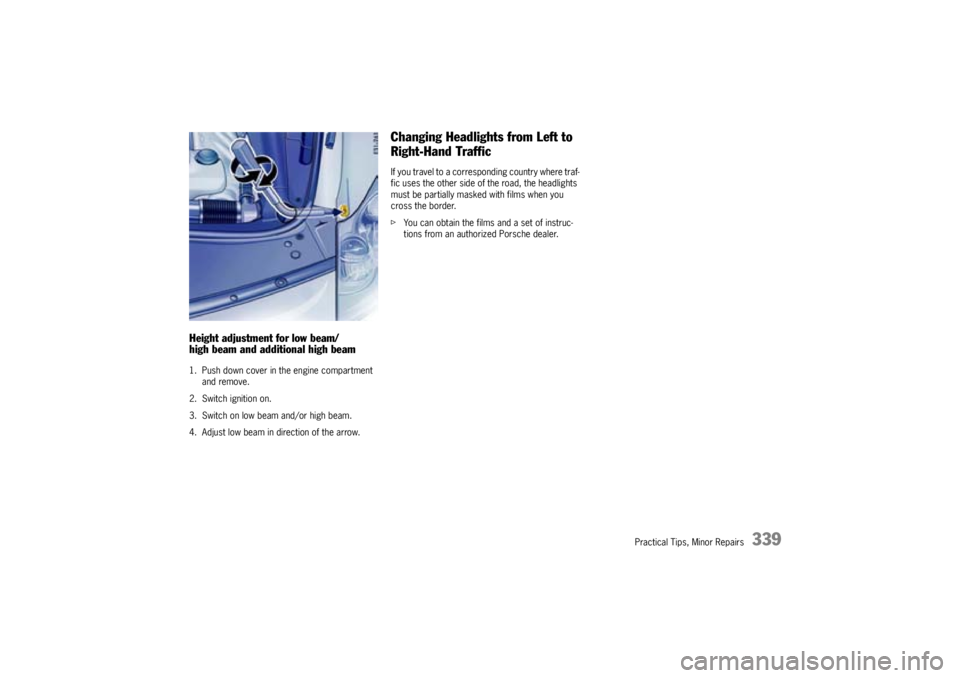
Practical Tips, Minor Repairs
339
Height adjustment for low beam/
high beam and additional high beam1. Push down cover in the engine compartment
and remove.
2. Switch ignition on.
3. Switch on low beam and/or high beam.
4. Adjust low beam in direction of the arrow.
Changing Headlights from Left to
Right-Hand TrafficIf you travel to a corresponding country where traf-
fic uses the other side of the road, the headlights
must be partially masked with films when you
cross the border.
fYou can obtain the films and a set of instruc-
tions from an authorized Porsche dealer.
Page 361 of 369

Index
361
Front windscreen wiper ............................... 120
Fuel .................................................... 74
,250
Economy ............................................ 249
Evaporation control ............................. 253
Level gauges ........................................ 74
Recommendations .............................. 252
Fuel containers, portable ........................ 6,253
Fuel gauge ................................................... 74
Fuel quality ..................................................... 8
Function keys ............................................... 53
Lighting ................................................ 54
Fuse assignment......................................... 305
Fuses......................................................... 303
GGarage door opener.................................... 162
Allocating ........................................... 163
Changeable code system .................... 163
Deleting ............................................. 164
Fixed code system .............................. 163
Gear display ............................................... 199
Glasses case .............................................. 172
Glove compartment .................................... 173
Gross weight .............................................. 191
Ground clearance .............................. 354
,355
HHand-held transmitter ......................... 162
,163
Hazard warning light switch ......................... 118
Headlight beam adjustment ................ 107,116
Headlights ................................ 194
,262
,329
Bi-Xenon ............................................. 331
Changing for left-hand traffic ................ 339Closing the housing lid.........................331
Height adjustment ...............................339
Opening the housing lid .......................331
Setting ...............................................338
Washer system ...................................120
Headrest ......................................................36
Installing ...............................................36
Removing .............................................36
Setting .................................................36
Heated rear window .........125
,126
,127
,131
Height adjustment ..............................211,228
High beam.........................................114,117
Indicator light .................................68,70
Switch ................................................117
High Range...............84
,200
,202
,207
,210
On-road driving program ......................206
High-pressure cleaning units.........................257
Horn ............................................................51
IIdentification number ...................................344
Idling..........................................................199
Ignition lock ..................................................58
Immobilizer...................................................19
Inclination sensor .....................21
,23,27,30
Function indication ................................27
Monitored areas ....................................28
Switching off.........................................27
Switching off, temporarily ......................28
Switching on .........................................27
Switching on, temporarily.......................28
Instrument panel
Lighting ..............................................116
Interior light, front .......................................144Interior lighting ........................................... 144
Interior mirror .............................................. 55
ISOFIX system .............................................. 48
JJack ................................................. 230
,283
Jacking point ............................................. 290
Jump lead starting
Leads ................................................ 324
Jumper cables ........................................... 323
KKeys............................................................ 17
Changing the battery .......................... 326
Emergency operation ........................... 18
Kickdown................................................... 201LLeather care .............................................. 263
Left-hand traffic.......................................... 339
Level control ... 83
,158
,175
,211
,228
,285
Loading level.................... 229
,230
,355
Low level ........................................... 228
Normal level....................................... 228
Special low level................................. 228
Special terrain level ............................ 228
Switching on and off ........................... 230
Warning light ...................................... 230
Licence plate light ...................................... 146
License plate light ...................................... 337